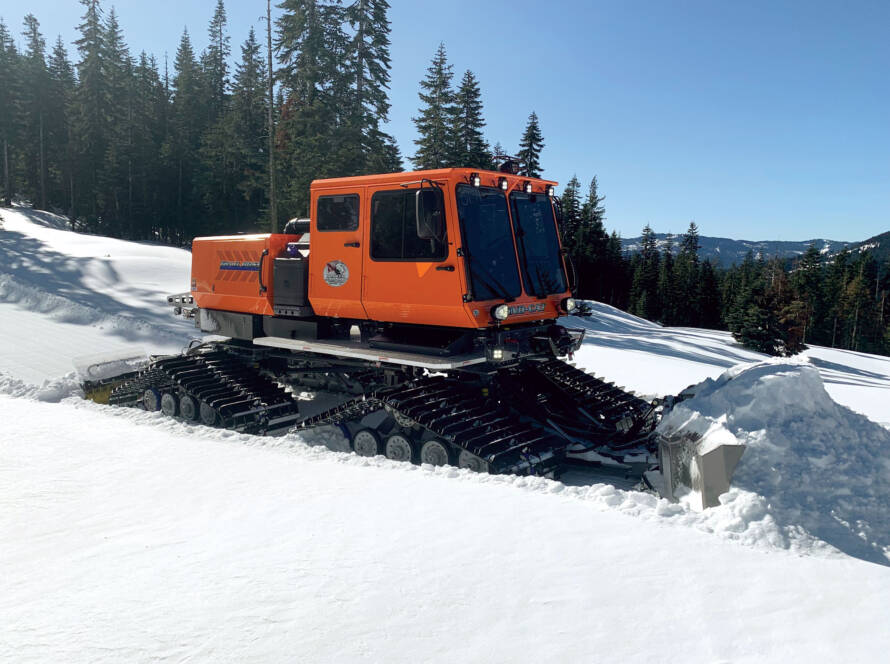In its ongoing effort to bring carbon neutrality to the snow operations industry, Prinoth is happy to introduce its two new concept machines: the Leitwolf h2Motion, the world’s first hydrogen-powered snow groomer, and the Husky eMotion, the world’s lightest electric snow groomer.
“We had a huge interest wave coming out of our announcement before Christmas, especially for the Husky eMotion,” said Andreas Muigg, Ph.D., Prinoth’s head of product portfolio management.
The difference between the two models is where and how the energy is stored and then provided to the hydraulic powertrain, he says. For now, both concept vehicles are conventional snow groomers except for the electric motors – the second, easier step will be to achieve full electrification of the powertrain.
“For the Husky eMotion, we replaced the diesel engine with batteries, and an electric motor runs the rest of the powertrain,” Muigg said, noting that this light, zero-exhaust machine will be ideal for indoor ski domes, smaller areas that require a high degree of maneuverability and urban facilities that have rigorous pollution or low-noise requirements.
There’s a notably lower noise level in the cabin, he said, “and it’s noticeable outside, too – a very positive effect.
“The concept is based on the existing machine, but we are able to get 272 horsepower (200 kilowatt hours) and 1,140 newton-meters in immediate maximum torque from start out of this battery capacity, which is about 20 percent more than in the diesel version. We installed a total capacity of 190 kilowatt hours, with a usable capacity of 150 kilowatt hours, which allows it to drive up to three hours in normal operation. The better the charging station infrastructure is on site, the faster it can be recharged, of course – six hours for AC, and less than an hour with DC.”
Aiming to be the hydrogen-powered category leader
“But there is a certain pivot point where being only on batteries doesn’t make sense anymore – the size, weight and charging capability give you some limits – so for the bigger groomers there has to be a different [fuel] source,” Muigg said. At this point the only relevant one is hydrogen.
Prinoth’s Leitwolf snow groomer already complies with rigorous Stage V European and Tier 4 final U.S. exhaust emission standards, but like all diesel-burning groomers, it still emits carbon dioxide, nitrogen oxides and particulate emissions. “That’s why we wanted to investigate the new path with the electrical machines,” said Muigg.
Batteries and fuel cells both produce power by converting chemical energy into electrical energy. Like batteries, fuel cells have no moving parts. However, unlike batteries, hydrogen fuel cells don’t run down or need recharging. Instead, their energy is produced through the electrochemical reaction that occurs when oxygen from the air combines with hydrogen fuel in the presence of a catalyst, converting hydrogen gas directly into low-voltage, direct-current electricity. The only by-products are heat and H2O – water vapor.
The Leitwolf h2Motion aims to be the category leader in hydrogen-powered machines, offering 544 horsepower (400 kWh) and immediate maximum 2,300 newton-meters of torque from start – more than twice that of the Husky model and even surpassing its own diesel version in terms of power. The high-capacity motor is powered by hydrogen fuel, which is pumped into the vehicle’s tank in much the same way as diesel fuel is pumped into a conventional vehicle at a gas station, and in about the same amount of time.
“When we go from diesel to alternative drives, we do have to rethink the filling cycles,” he said. “With the Leitwolf concept vehicle, we aimed for a final grooming operation of four hours,” about half of the current diesel model’s normal shift time.
“The aim of a concept vehicle is to be flexible and see how it works,” said Muigg. “Both vehicles will be further optimized. A market entry will depend on the test period’s findings and further developments – the Husky eMotion will be faster for sure, and we expect an introduction in one to two years. The Leitwolf h2Motion’s market introduction can be expected in about four to five years, mainly driven by the infrastructure.
“It may take a few years before hydrogen fuel is more widely available on the consumer market,” for example, said Muigg, and operators will need training to store and handle hydrogen in on-site fueling stations. As both vehicles are still in development, it’s not clear what they’ll cost. “More, for sure, because of the available technologies. But technology is moving fast, so we will see.”
The aim is to be flexible and see how it works
Until now, snow groomers the world over have relied on the consumption of diesel. Ultimately, cheaper fueling and maintenance costs may result in savings, making electric alternatives more price-competitive with diesel-powered vehicles. “But the whole concept has to make sense for the ski resort – the customer – not just from an ecological point of view, but also from an economical point of view,” said Muigg. Prinoth is still investigating a number of variables, some in consultation with resort operators.
Climate change is impacting ski areas all over the world and many resort owners are prepared to invest in green technologies to attract skiers who, conscientious about their own environmental footprints, are looking for the greenest alternatives. Since 1993, the National Ski Areas Association has celebrated the best North American ski area sustainability programs with its annual Golden Eagle Awards, and more than 200 U.S. ski operations participate in its Sustainable Slopes program, pledging to “incorporate sustainability into all aspects of our resorts.” Internationally, many resorts have also sought to become more sustainable, from improving their snowmaking efficiency to using solar panels, wind turbines and on-site hydroelectric systems to generate electricity in their efforts to bring carbon neutrality to their operations and earn Flocon Vert, Alpine Pearls and other similar designations.
“The trend is toward environmentally friendly technologies, and we want to be part of this direction as well,” said Muigg. The Leitwolf h2Motion concept vehicle was displayed during this past winter’s Ski World Cup races at Alta Badia, and at the Cortina 2021 Alpine World Ski Championships, both in Italy.
“Obviously, the ski business depends on healthy nature,” he said. “We want to get the ski business to zero emissions. This is our first step.”

